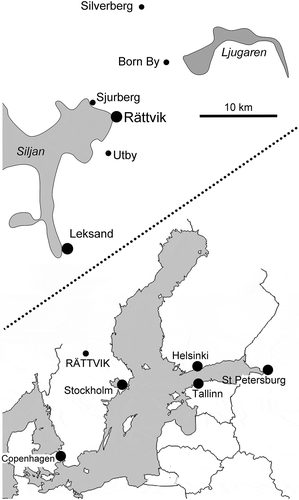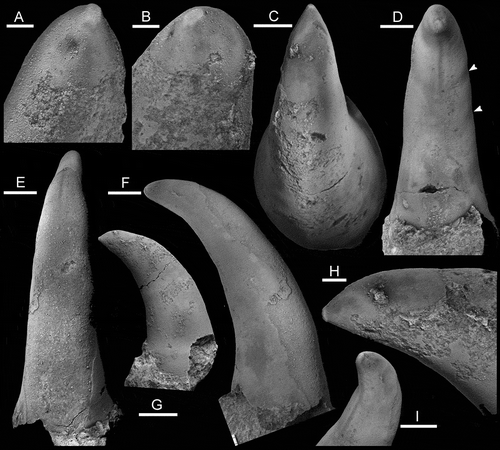Figures & data
Figure 1. Localities for Pollicina cyathina Koken, Citation1897 in the Rättvik area of Dalarna, central Sweden.

Figure 2. Pollicina from the Ordovician of Estonia and Russia. A. C–E. Pollicina crassistesta Koken, Citation1897, Ordovician, Darriwilian Series, Kunda Stage, Estonia. A, C. ELM g8:23 [1208g8/23], lectotype, largely exfoliated specimen in lateral view (A) with detail of ornamentation (C), original of Koken & Perner (Citation1925, pl. 38, fig. 9), Domberg (= Toompea). D, E. ELM g8:7 [1208g8/7], paralectotype, internal mould in lateral (D) and sub-apical (E) views, Springthal (= Tondi), original of Koken & Perner (Citation1925, pl. 38, figs. 1, 2). B, F. Pollicina corniculum Koken in Holzapfel, Citation1895, Ordovician, Darriwilian Series, Kunda Stage, Pulkova [Pulkowa], St Petersburg. B. PSM 4/22, lectotype in lateral view. F. CNIGRM 15702 (200/10903), lateral view with deep scratches resulting from preparation on right side. Scale bars: 5 mm.
![Figure 2. Pollicina from the Ordovician of Estonia and Russia. A. C–E. Pollicina crassistesta Koken, Citation1897, Ordovician, Darriwilian Series, Kunda Stage, Estonia. A, C. ELM g8:23 [1208g8/23], lectotype, largely exfoliated specimen in lateral view (A) with detail of ornamentation (C), original of Koken & Perner (Citation1925, pl. 38, fig. 9), Domberg (= Toompea). D, E. ELM g8:7 [1208g8/7], paralectotype, internal mould in lateral (D) and sub-apical (E) views, Springthal (= Tondi), original of Koken & Perner (Citation1925, pl. 38, figs. 1, 2). B, F. Pollicina corniculum Koken in Holzapfel, Citation1895, Ordovician, Darriwilian Series, Kunda Stage, Pulkova [Pulkowa], St Petersburg. B. PSM 4/22, lectotype in lateral view. F. CNIGRM 15702 (200/10903), lateral view with deep scratches resulting from preparation on right side. Scale bars: 5 mm.](/cms/asset/0e672dd9-67ae-40ce-bfe2-1a12898f4f2f/sgff_a_1728374_f0002_b.gif)
Figure 3. Pollicina from the Ordovician of Sweden and Estonia. A–D, G, H. Pollicina cyathina Koken, Citation1897, A–D. PMU 35717 from Rättvik, Dalarna. A. close up sub-apical surface showing fine comarginal growth lines on adaperturally tapering growth lamellae disturbed by penetrative fractures (arrows 1–3) repaired during life. B. view of sub-apical surface showing broken apex. C. detail of broken apex showing circular cross-section and thick shell. D. lateral view. G, H. SMNH Mo 7767, holotype by monotypy, original specimen of Koken & Perner (Citation1925, pl. 38, figs. 6,7). Born [Borns] By, Rättvik, Dalarna. Lower Grey Orthoceras Limestone (Holen Limestone, Darriwilian Series, Kunda Stage; Ebbestad & Högström Citation2007). E, F. Pollicina crassistesta Koken, Citation1897, ELM 1201: g1:2664, Tallinn, Ordovician, Darriwilian Series, Kunda Stage, Estonia. A. slightly oblique view from perspective of sub-apical surface showing laterally flattened internal mould overlain by extremely thick shell (arrows mark lateral margin of shell). F. lateral view of internal mould and enveloping thick shell (arrows mark margin of shell on supra-apical surface). Scale bars: A, C (2 mm), B, D (4 mm), E, F (1 mm), G, H (5 mm).
![Figure 3. Pollicina from the Ordovician of Sweden and Estonia. A–D, G, H. Pollicina cyathina Koken, Citation1897, A–D. PMU 35717 from Rättvik, Dalarna. A. close up sub-apical surface showing fine comarginal growth lines on adaperturally tapering growth lamellae disturbed by penetrative fractures (arrows 1–3) repaired during life. B. view of sub-apical surface showing broken apex. C. detail of broken apex showing circular cross-section and thick shell. D. lateral view. G, H. SMNH Mo 7767, holotype by monotypy, original specimen of Koken & Perner (Citation1925, pl. 38, figs. 6,7). Born [Borns] By, Rättvik, Dalarna. Lower Grey Orthoceras Limestone (Holen Limestone, Darriwilian Series, Kunda Stage; Ebbestad & Högström Citation2007). E, F. Pollicina crassistesta Koken, Citation1897, ELM 1201: g1:2664, Tallinn, Ordovician, Darriwilian Series, Kunda Stage, Estonia. A. slightly oblique view from perspective of sub-apical surface showing laterally flattened internal mould overlain by extremely thick shell (arrows mark lateral margin of shell). F. lateral view of internal mould and enveloping thick shell (arrows mark margin of shell on supra-apical surface). Scale bars: A, C (2 mm), B, D (4 mm), E, F (1 mm), G, H (5 mm).](/cms/asset/dede96a9-92cc-43e4-9937-471ceda1f214/sgff_a_1728374_f0003_b.gif)
Figure 4. Pollicina cyathina Koken, Citation1897 from Dalarna, Sweden, Ordovician, Darriwilian Series, Kunda Stage, Lower Grey Orthoceras Limestone (Holen Limestone; Ebbestad & Högström Citation2007). A–C, G, H. LO 12 441t, internal mould, Utby, Dalarna. A, B. views of smooth nodose tip. C. dorsal view of supra-apical surface showing pointed apex. G. lateral view showing pointed apex. H. detail of raised tip in lateral view. D–F, I. LO 12 442t, internal mould, Sjurberg. D. sub-apical surface showing apical node and periodic slight constrictions (arrows) of lateral profile during growth. E. supra-apical surface. F. lateral view. I. oblique lateral view of apex. Scale bars: A, B, H (1 mm), C (2mm), D–G, I (5 mm).

